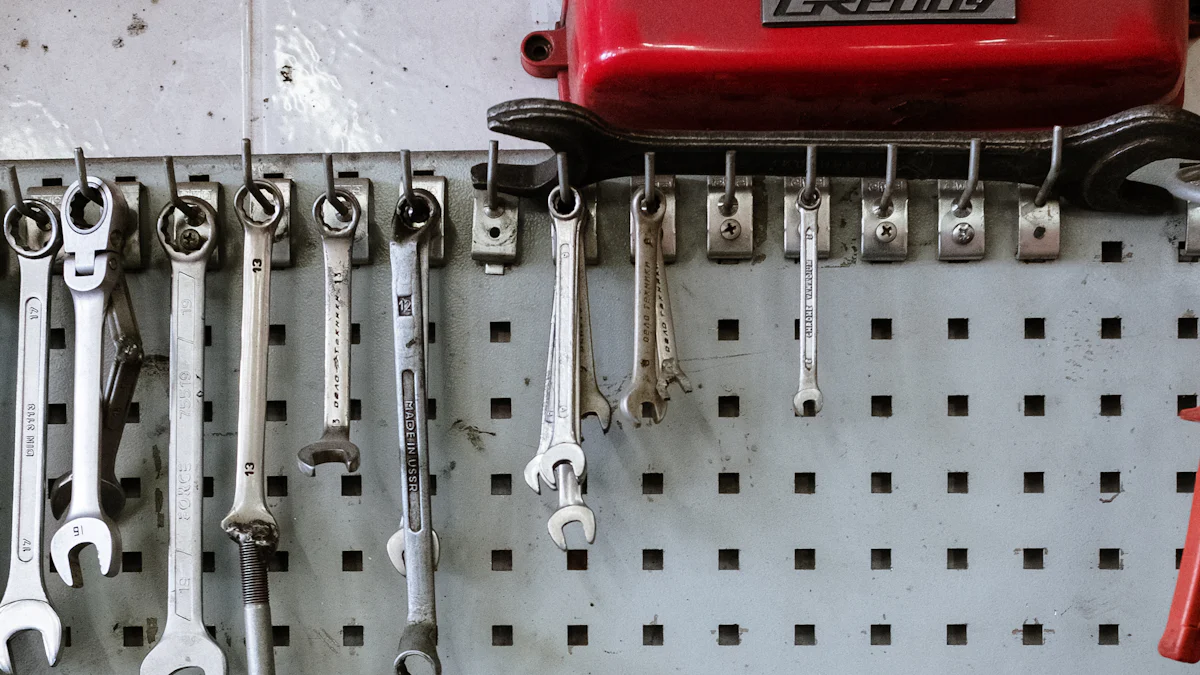
A torque multiplier wrench is an essential tool for anyone working with large bolts and heavy-duty fasteners. This specialized device increases the torque applied by an operator, making it possible to achieve precise and powerful torque application. Proper use of a torque multiplier wrench ensures connections are tightened according to specifications, preventing over-tightening and structural damage. Accurate torque application is crucial in industries such as construction and automotive maintenance, where safety and efficiency are paramount.
Understanding Torque Multiplier Wrenches
What is a Torque Multiplier Wrench?
Definition and Purpose
A torque multiplier wrench is a specialized tool designed to increase the torque applied by an operator. This tool is essential for tasks involving large bolts and heavy-duty fasteners. The primary purpose of a torque multiplier wrench is to enable users to apply greater torque without requiring additional physical strain. This makes it particularly useful in industries such as construction and automotive maintenance, where high torque is often necessary.
Key Components
A torque multiplier wrench consists of several key components:
- Input Drive: The part where the operator applies force using a standard torque wrench.
- Gear Mechanism: Typically an epicyclic gear train that multiplies the input torque.
- Output Drive: The part that delivers the multiplied torque to the fastener.
- Reaction Arm: A component that absorbs the counterforce generated during torque application.
How Does a Torque Multiplier Wrench Work?
Mechanical Advantage
The mechanical advantage of a torque multiplier wrench lies in its ability to amplify the input torque. When an operator applies force to the input drive, the internal gear mechanism multiplies this force. This allows for the application of higher torque levels without exerting excessive physical effort. This feature is particularly beneficial when dealing with stubborn or large fasteners.
Gear Ratios
Gear ratios play a crucial role in the functionality of a torque multiplier wrench. The gear ratio determines how much the input torque is multiplied. For example, a 4:1 gear ratio means that the output torque is four times the input torque. Understanding the gear ratio is essential for setting the correct torque levels and ensuring accurate torque application.
Types of Torque Multiplier Wrenches
Manual Torque Multipliers
Manual torque multipliers offer a range of output torques from manual inputs. These tools provide accurate and efficient torque multiplication for the make-up or break-out of joint fasteners. Manual torque multipliers are ideal for situations where power sources are unavailable. They are commonly used in industrial settings for loosening and tightening large bolts.
Powered Torque Multipliers
Powered torque multipliers include pneumatic and hydraulic versions. Pneumatic torque multipliers are tough and reliable tools designed for fast, safe, and simple fastening applications. Hydraulic torque multipliers work with microprocessors that control torque multiplication through an in-built controller. These powered options provide precise and powerful torque application, making them suitable for high-demand industrial tasks.
Benefits of Using a Torque Multiplier Wrench
Increased Efficiency
Time-Saving
A torque multiplier wrench significantly reduces the time required for tightening or loosening large bolts. Traditional methods often demand considerable effort and multiple attempts to achieve the desired torque. However, a torque multiplier wrench streamlines this process. For example, a pneumatic torque multiplier used in manufacturing large gas engines increased production time and eliminated costly rework. This efficiency proves invaluable in industrial settings where time equates to money.
Reduced Physical Strain
Using a torque multiplier wrench minimizes physical strain on operators. The tool’s design allows for the application of high torque with minimal effort. This feature is particularly beneficial in scenarios involving repetitive tasks or hard-to-reach fasteners. A manual torque multiplier used in coal mines for maintenance applications showcased this advantage by reducing the physical burden on workers. The reduced strain enhances productivity and lowers the risk of injury.
Enhanced Precision
Consistent Torque Application
A torque multiplier wrench ensures consistent torque application, which is crucial for maintaining the integrity of mechanical connections. Inconsistent torque can lead to uneven stress distribution and potential failure of components. The use of a hand torque multiplier in testing suspension bolts demonstrated the tool’s ability to provide uniform torque across multiple applications. Consistency in torque application enhances the reliability and safety of assembled structures.
Minimizing Errors
Accurate torque application minimizes errors that could compromise the functionality of machinery. Over-tightening or under-tightening fasteners can result in costly repairs and downtime. A torque wrench used for tightening large counterweights on medical equipment ensured precise torque specifications, preventing potential malfunctions. The precision offered by a torque multiplier wrench reduces the likelihood of errors, thereby extending the lifespan of equipment and improving overall operational efficiency.
Step-by-Step Guide to Using a Torque Multiplier Wrench

Preparation
Selecting the Right Tool
Choosing the correct torque multiplier wrench is crucial for achieving accurate torque application. Consider the required torque range and the type of fasteners involved. Manual torque multipliers suit situations without power availability. Powered torque multipliers, such as pneumatic or hydraulic versions, are ideal for high-demand tasks. Always refer to the manufacturer’s specifications to ensure compatibility with the intended application.
Inspecting the Wrench
Before use, inspect the torque multiplier wrench for any signs of wear or damage. Check the input and output drives for smooth operation. Ensure the gear mechanism functions correctly. Verify that the reaction arm is secure and free from defects. Regular inspection prevents potential malfunctions and ensures safe operation.
Application
Setting the Torque
Set the torque wrench according to the required torque value. Divide the desired torque by the multiplication factor of the torque multiplier wrench. For example, if the required torque is 400 Nm and the multiplication factor is 4:1, set the torque wrench to 100 Nm. Accurate setting ensures precise torque application and prevents over-tightening or under-tightening.
Applying the Wrench
Attach the torque wrench to the input drive of the torque multiplier wrench. Position the reaction arm against a solid surface to absorb the counterforce. Apply force to the torque wrench until it clicks, indicating the desired torque has been reached. Maintain a steady and controlled motion to ensure consistent torque application. Proper technique enhances the reliability and safety of the connection.
Post-Use Care
Cleaning and Maintenance
After use, clean the torque multiplier wrench to remove any dirt or debris. Use a soft cloth and mild cleaning solution to wipe down the components. Lubricate the gear mechanism as per the manufacturer’s recommendations. Regular maintenance prolongs the lifespan of the tool and ensures optimal performance.
Storage Tips
Store the torque multiplier wrench in a dry and secure location. Avoid exposure to extreme temperatures or humidity. Use a protective case to prevent damage during storage. Proper storage practices maintain the integrity of the tool and ensure readiness for future use.
Safety Tips for Using a Torque Multiplier Wrench
Personal Protective Equipment (PPE)
Gloves and Safety Glasses
Operators must wear gloves and safety glasses when using a torque multiplier wrench. Gloves protect hands from potential injuries caused by slipping or sharp edges on fasteners. Safety glasses shield eyes from debris or accidental impacts during torque application. Proper PPE ensures a safer working environment, reducing the risk of injury.
Proper Handling Techniques
Avoiding Over-Torquing
Over-torquing can damage fasteners and compromise the integrity of mechanical connections. Operators should always set the torque wrench according to the required torque value. Divide the desired torque by the multiplication factor of the torque multiplier wrench. For example, if the required torque is 400 Nm and the multiplication factor is 4:1, set the torque wrench to 100 Nm. This method ensures precise torque application and prevents over-torquing.
Safe Storage Practices
Proper storage of a torque multiplier wrench maintains its functionality and extends its lifespan. Store the tool in a dry and secure location. Avoid exposure to extreme temperatures or humidity. Use a protective case to prevent damage during storage. Regular maintenance and proper storage practices ensure the tool remains ready for future use.
Proper use of a torque multiplier wrench ensures safety and efficiency. Key points include understanding the tool’s mechanics, selecting the right type, and following a step-by-step guide for application. Safety measures such as wearing gloves and safety glasses prevent injuries. Regular inspection and maintenance extend the tool’s lifespan. Practicing these guidelines enhances proficiency and confidence in using torque multiplier wrenches. Accurate torque application prevents structural damage and ensures reliable connections.
See Also
Revolutionary Upgrades for Scooter’s Peak Performance
Essential Tips for Warm Winter with Cozy Socks and Towels
